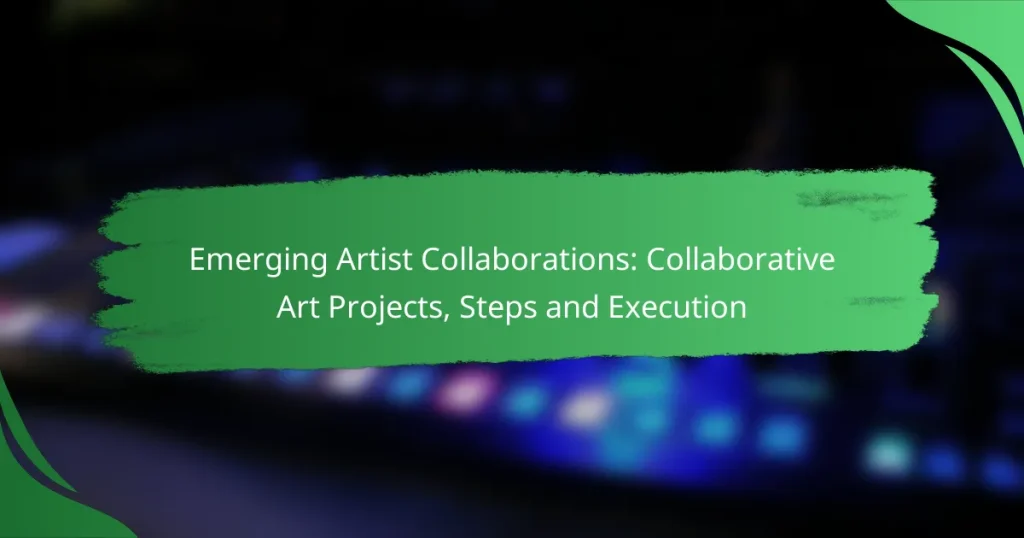Collaborative art projects present emerging artists with unique opportunities to blend their skills and creativity, enhancing visibility and fostering community connections. By following key steps such as defining project goals and promoting the final work, artists can effectively align their visions and manage resources. These partnerships not only elevate individual profiles but also encourage the exchange of diverse ideas, leading to significant artistic growth.
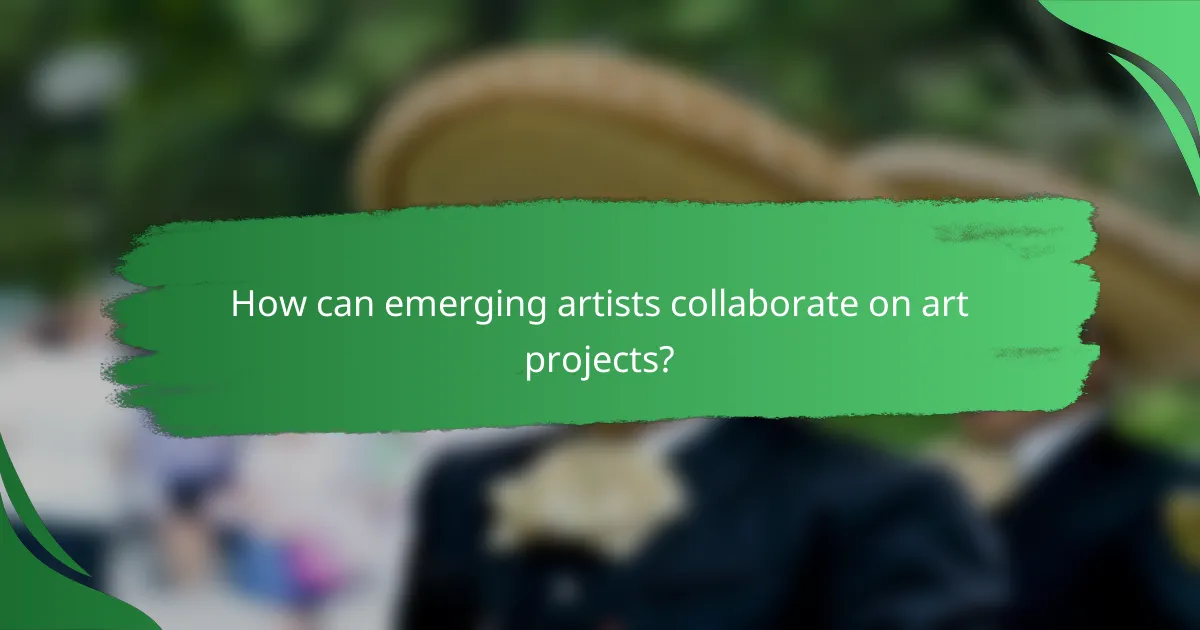
How can emerging artists collaborate on art projects?
Emerging artists can collaborate on art projects by engaging in various formats that leverage their skills and creativity. These collaborations can enhance visibility, foster community connections, and provide unique opportunities for artistic growth.
Joint exhibitions
Joint exhibitions allow multiple artists to showcase their work together, creating a cohesive theme or narrative. This format can attract larger audiences and share costs for venue rental and promotion. Artists should consider how their styles complement each other to create a unified experience.
When planning a joint exhibition, establish clear roles and responsibilities, from curating the artwork to marketing the event. Setting a timeline and budget can help streamline the process and ensure all artists are aligned on expectations.
Collaborative installations
Collaborative installations involve artists working together to create immersive environments that engage viewers. This type of project often requires a shared vision and extensive planning, as it may include various media such as sculpture, video, or sound.
To execute a successful installation, artists should communicate openly about their ideas and techniques. Consideration of the installation space is crucial, as it can influence the overall impact of the artwork. Documenting the process can also provide valuable insights for future collaborations.
Online art challenges
Online art challenges invite artists to create work based on specific prompts or themes, often within a set timeframe. These challenges can foster community engagement and allow artists to showcase their talents to a broader audience through social media platforms.
Participating in these challenges can help artists build their portfolios and gain followers. It’s essential to use relevant hashtags and engage with other participants to maximize visibility and create connections within the art community.
Community mural projects
Community mural projects involve artists collaborating to create large-scale artworks in public spaces, often reflecting local culture or social issues. These projects can enhance community pride and beautify neighborhoods while providing artists with valuable exposure.
When organizing a mural project, artists should engage with community members to gather input and ensure the artwork resonates with local values. Securing necessary permits and funding is also critical to avoid legal issues and ensure project sustainability.
Art fairs participation
Participating in art fairs allows emerging artists to network, sell their work, and gain exposure to potential buyers and galleries. Collaborating with other artists to share a booth can reduce costs and create a more dynamic presentation.
Before committing to an art fair, research the event’s audience and reputation to ensure it aligns with your artistic goals. Preparing promotional materials and a cohesive display will help attract visitors and facilitate meaningful conversations about your work.
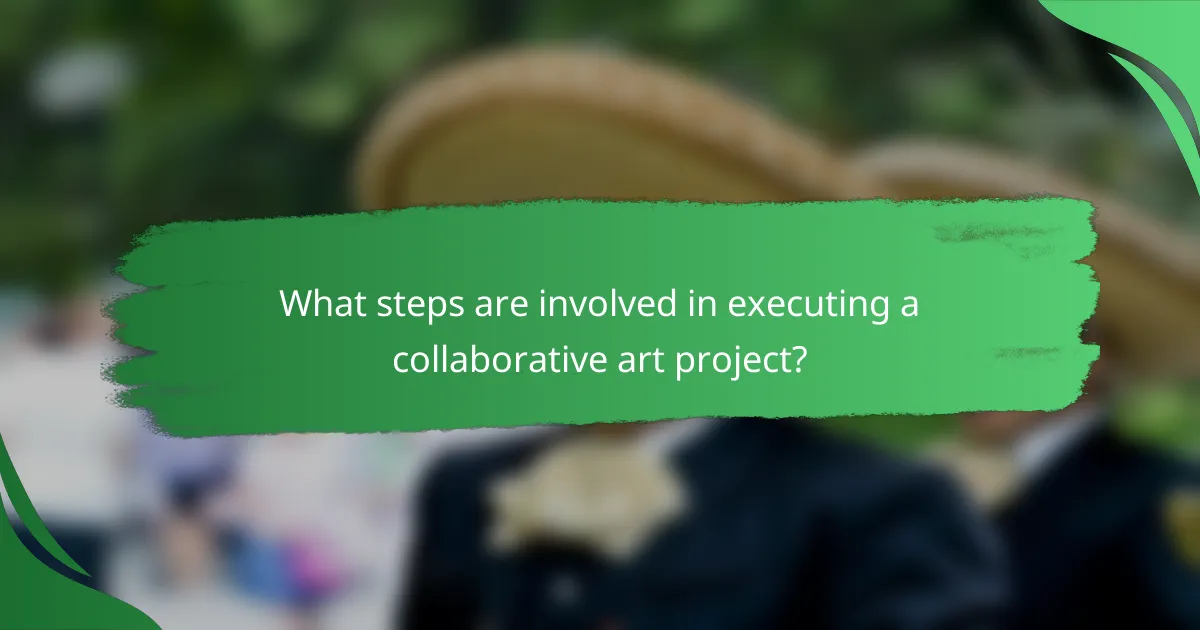
What steps are involved in executing a collaborative art project?
Executing a collaborative art project involves several key steps that ensure effective teamwork and successful outcomes. From defining project goals to promoting the final work, each stage is crucial for aligning the artists’ visions and managing resources efficiently.
Define project goals
Defining project goals is the first step in any collaborative art project. Clear objectives help guide the artistic direction and ensure all participants are on the same page. Consider what themes, messages, or experiences you want to convey through the collaboration.
Engage all team members in this process to gather diverse perspectives, which can enrich the project’s vision. Setting measurable goals can also help track progress and evaluate success at the project’s conclusion.
Gather a team of artists
Assembling a team of artists is essential for bringing varied skills and creative ideas to the project. Look for individuals whose artistic styles complement each other and who share a commitment to the project’s goals. Networking events, social media, and local art communities can be effective avenues for finding collaborators.
Consider the dynamics of the team, as effective communication and collaboration are key to a successful partnership. Establish roles based on each artist’s strengths to streamline the creative process.
Establish a timeline
Creating a timeline helps keep the project organized and on track. Start by outlining major milestones, such as brainstorming sessions, drafts, and final presentations. Assign deadlines for each phase to ensure accountability among team members.
Be realistic about the time required for each task, allowing for flexibility in case of unforeseen challenges. Regular check-ins can help maintain momentum and address any issues that arise during the project.
Allocate budget and resources
Budgeting is a critical step in executing a collaborative art project. Determine the overall financial resources available and allocate funds for materials, venue rental, and promotional activities. Consider seeking sponsorships or grants to supplement your budget.
Resource allocation should also include time and human resources. Ensure that all team members understand their responsibilities and the resources they have at their disposal to avoid misunderstandings later on.
Promote the project
Promotion is vital for generating interest and attracting an audience to your collaborative art project. Utilize social media platforms, local art networks, and community events to share updates and engage potential viewers. Create visually appealing promotional materials that reflect the project’s themes and artistic style.
Consider hosting an opening event or exhibition to showcase the final work. This not only highlights the collaboration but also fosters community engagement and support for the artists involved.
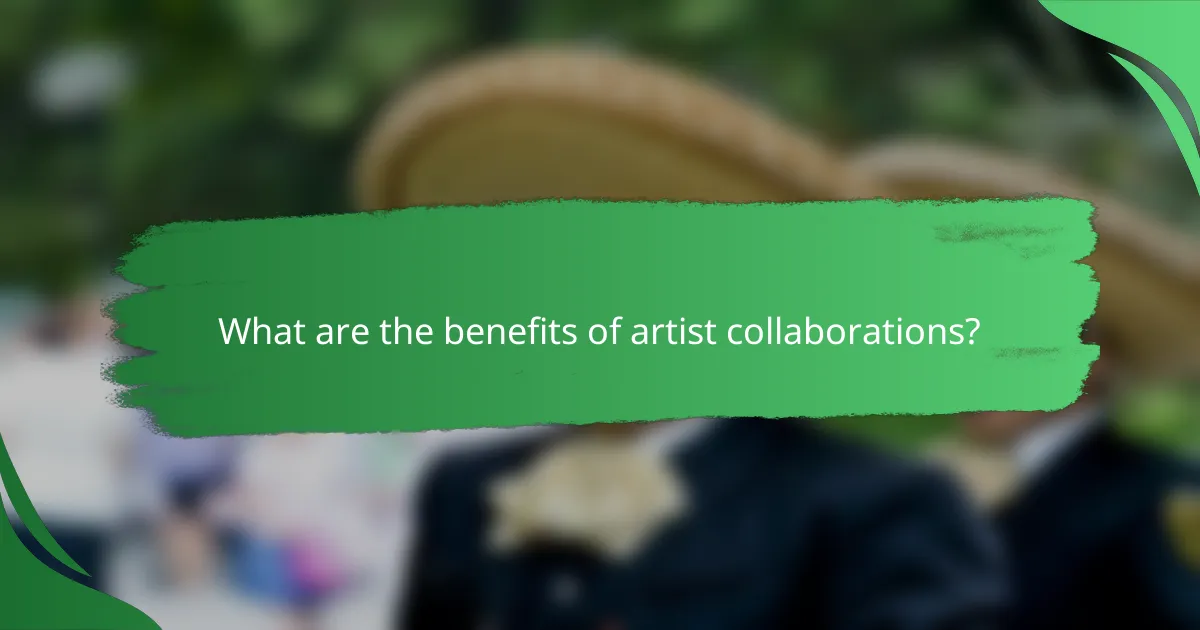
What are the benefits of artist collaborations?
Artist collaborations offer numerous advantages, including enhanced exposure, resource sharing, and the infusion of diverse ideas. These partnerships can significantly elevate an artist’s profile and foster creative growth.
Increased visibility
Collaborating with other artists can lead to increased visibility for all parties involved. By combining audiences, artists can reach a broader demographic, which is particularly beneficial for emerging talents looking to establish their presence in the art world.
For example, a joint exhibition can attract more visitors than a solo show, as each artist promotes the event to their followers. This shared promotion can lead to greater media coverage and online engagement.
Shared resources
Artist collaborations often involve sharing resources, such as studio space, materials, and funding. This can reduce individual costs and allow artists to experiment with new techniques or larger projects that they might not be able to afford alone.
For instance, two artists might pool their budgets to rent a larger gallery space for a joint exhibition, making it more feasible to showcase their work effectively. This resource-sharing can also include access to each other’s networks for supplies or technical expertise.
Diverse perspectives
Working with other artists introduces diverse perspectives that can enrich the creative process. Each artist brings their unique style, background, and ideas, which can lead to innovative outcomes that neither could achieve alone.
For example, a painter collaborating with a sculptor may create a mixed-media installation that combines both forms, resulting in a fresh artistic expression. This blending of ideas can challenge artists to think outside their usual boundaries.
Networking opportunities
Collaborative projects provide valuable networking opportunities that can lead to future partnerships and career advancements. Artists can connect with each other’s contacts, expanding their professional circles significantly.
Participating in joint exhibitions or community art projects can introduce artists to curators, collectors, and other creatives who may offer further collaboration or support. Building these relationships can be crucial for an emerging artist’s career development.
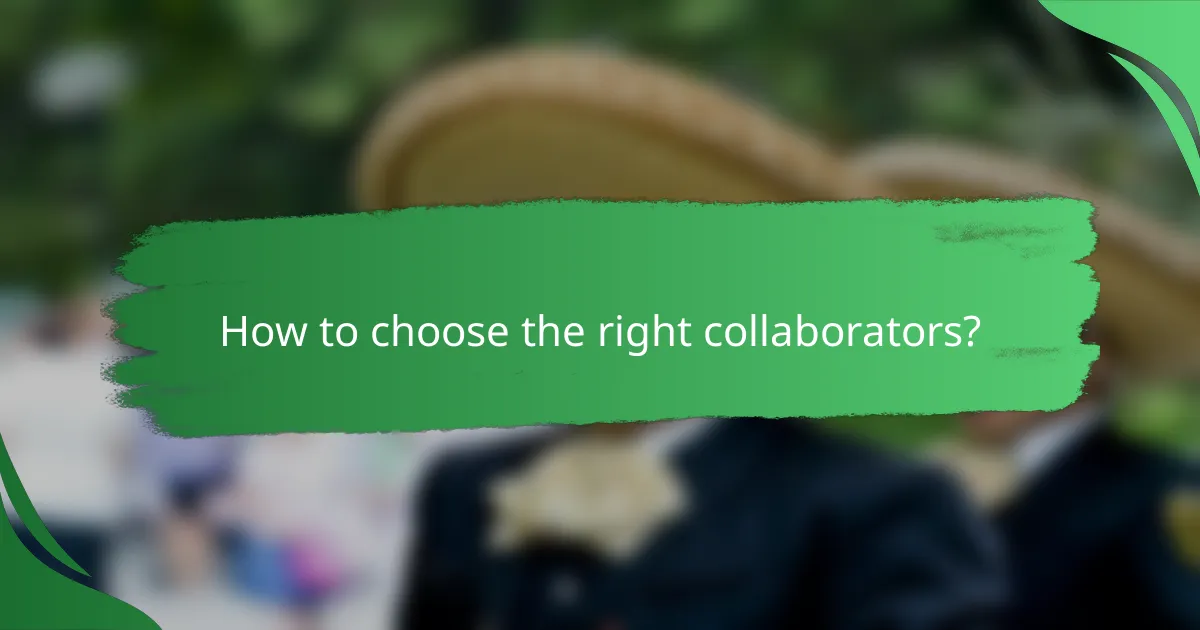
How to choose the right collaborators?
Choosing the right collaborators is essential for successful artistic projects. Focus on aligning artistic vision, compatibility, and audience engagement to ensure a fruitful partnership.
Evaluate artistic styles
Assessing artistic styles is crucial when selecting collaborators. Look for artists whose work complements your own, whether through similar themes, techniques, or mediums. This alignment can enhance the overall impact of the project.
Consider creating a mood board or a visual reference guide that showcases the styles of potential collaborators. This can help clarify how different artistic approaches might blend together effectively.
Assess compatibility
Compatibility goes beyond artistic styles; it includes communication, work ethic, and shared goals. Discuss your expectations and creative processes upfront to identify any potential conflicts. A successful collaboration often hinges on mutual respect and understanding.
Engage in preliminary discussions or small projects together to gauge how well you work as a team. This trial period can reveal whether your collaborative dynamics are conducive to a larger project.
Consider audience reach
Understanding each collaborator’s audience can significantly influence the project’s success. Evaluate how their existing followers align with your target demographic. A diverse audience can amplify the reach and impact of your collaborative work.
Utilize social media analytics or previous project outcomes to assess audience engagement. This data can guide your decision on which collaborators might help you reach new viewers or deepen connections with existing fans.
